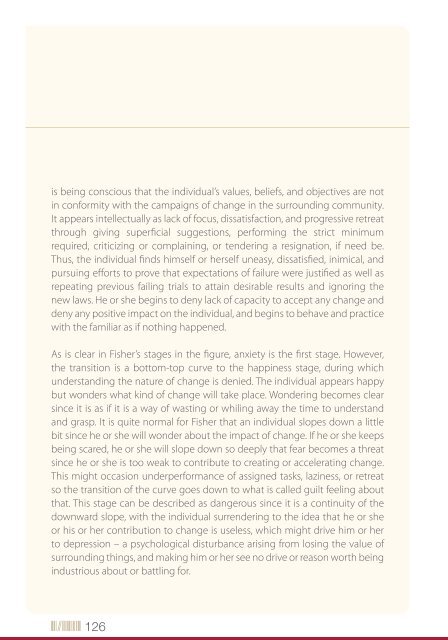General Supervisor
General Supervisor
General Supervisor
You also want an ePaper? Increase the reach of your titles
YUMPU automatically turns print PDFs into web optimized ePapers that Google loves.
is being conscious that the individual’s values, beliefs, and objectives are not<br />
in conformity with the campaigns of change in the surrounding community.<br />
It appears intellectually as lack of focus, dissatisfaction, and progressive retreat<br />
through giving superficial suggestions, performing the strict minimum<br />
required, criticizing or complaining, or tendering a resignation, if need be.<br />
Thus, the individual finds himself or herself uneasy, dissatisfied, inimical, and<br />
pursuing efforts to prove that expectations of failure were justified as well as<br />
repeating previous failing trials to attain desirable results and ignoring the<br />
new laws. He or she begins to deny lack of capacity to accept any change and<br />
deny any positive impact on the individual, and begins to behave and practice<br />
with the familiar as if nothing happened.<br />
As is clear in Fisher’s stages in the figure, anxiety is the first stage. However,<br />
the transition is a bottom-top curve to the happiness stage, during which<br />
understanding the nature of change is denied. The individual appears happy<br />
but wonders what kind of change will take place. Wondering becomes clear<br />
since it is as if it is a way of wasting or whiling away the time to understand<br />
and grasp. It is quite normal for Fisher that an individual slopes down a little<br />
bit since he or she will wonder about the impact of change. If he or she keeps<br />
being scared, he or she will slope down so deeply that fear becomes a threat<br />
since he or she is too weak to contribute to creating or accelerating change.<br />
This might occasion underperformance of assigned tasks, laziness, or retreat<br />
so the transition of the curve goes down to what is called guilt feeling about<br />
that. This stage can be described as dangerous since it is a continuity of the<br />
downward slope, with the individual surrendering to the idea that he or she<br />
or his or her contribution to change is useless, which might drive him or her<br />
to depression – a psychological disturbance arising from losing the value of<br />
surrounding things, and making him or her see no drive or reason worth being<br />
industrious about or battling for.<br />
126<br />
This stage is dangerous for two reasons: First, a psychological state is<br />
characterized by dissemination, which means that the individual that reaches<br />
this state will begin to spread the uselessness culture, highlighting the<br />
disadvantages and repercussions of new plans as well as retreating from giving<br />
any help or from doing his assignments at a minimal level of performance just<br />
to avoid embarrassment and save face, and feeling as if he or she did a lot. The<br />
second reason is that it is a turning point for the individual, who will either<br />
enjoy some insight and capacity to face up to the self and balance things so<br />
that the transition slope goes up anew, or the individual considers this change<br />
very costly for his own considerations and values, thus exhausting his or her<br />
last trials to try to stop change, and resorting to more violent appeals through<br />
resigning or disturbing the others’ concentration and efforts.<br />
How can the stages of transition toward change be difficult?<br />
If we take for granted these stages of transition toward change till stability,<br />
we will notice that individuals are engrossed in different ways at each stage in<br />
seeing stability and change and enjoying the required skills to grasp change.<br />
There are certain personal characteristics that distinguish individuals, and<br />
make change more difficult for some of them.<br />
Rigidity, rudeness, lack of self-control, and evasion of responsibility are all<br />
characteristics that use up individuals’ energy in bearing the burden of<br />
change, and make accepting it by these individuals remarkably more difficult<br />
than by those who enjoy a highly firm psychological state that assist them in<br />
acclimatizing themselves and in being more flexible and capable of assuming<br />
responsibility and perseverance.<br />
Rigidity: such as the incapacity to acclimatize oneself to the change of culture<br />
in the organization, incapacity to be responsive to others’ demands to change<br />
some features of their personality, and incapacity to effectively listen and learn.<br />
127


